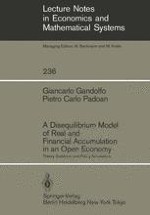This is the fourth version of a model that five years ago we set out to build and estimate along the lines of the continuous time approach clarified In chapter 1. Previous versions appeared in journal articles and conference proceedings, where the space is notoriously limited. Therefore we welcome the possibility of publishing a book-length treatment of this fourth version, so that we can describe its theoretical and empirical aspects in some detail. Although we have worked closely together and accept joint responsibility for the whole book, chs. 1 and 2 and appendix I have been written by G. Gandolfo, whilst chs. ] and 4 and appendix II have been written by P.c. Padoan. Different parts of this version of the model have been discussed In various lectures at the European University Institute (Florence) in 1984, In a seminar organized by the Bank of Italy (Sadiba, Perugia, Italy, February 16-18, 1984), in the second Viennese Workshop on Economic Applications of Control Theory (Vienna, May 16-18, 1984), and in the sixth annual Conference of the Society for Economic Dynamics and Control (Nice, France, June 13-15, 1984). In all of these we received helpful comments; similarly helpful were the comments of Clifford R .. Wymer, who, however, is absolved of any responsibility.
